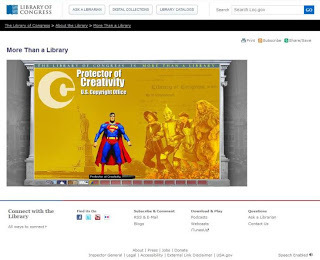Marc Tyler Nobleman's Blog, page 119
September 21, 2012
Superman on Library of Congress site
Published on September 21, 2012 04:00
September 18, 2012
Prince vs. Rogue
In 2004, as I prepared to join the ranks of authors who do school visits, I was aware that my books to date did not have a high recognition factor. (Read: no one had heard of me.) I needed to stand out in some other way.
So I worked up a theme (other than my work itself) and drew two characters to cutely (or so I thought) represent that theme:
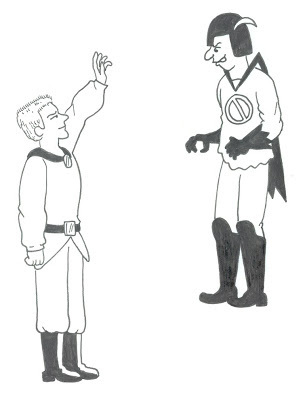 The title I gave my presentation:
The title I gave my presentation:
"The Prince of Persistence vs. The Rogue of Rejection School Visit: The Hits and Misses of a Professional Writer/Cartoonist"
It’s about a paragraph too long.
As if that alone wasn’t wordy enough, here was what appeared directly under it on the first flyer I sent out:
On one level, this doesn’t even make sense. The Prince of Persistence can live within any of us; the Rogue of Rejection, however, is within some of the people to whom we send our work. My Prince and Rogue are not two sides to one person, as I clumsily thought; rather they are, simply, two different people. In other words, we don’t reject our own work.
Hey, I meant well.
Amazingly, one school of the first 400 I approached made it through that flyer yet still booked me. I revamped the flyer considerably for round 2.
My school presentations still revolve around these two ideas, but I’ve long since retired the Prince and the Rogue. Obviously I’ve retained a fondness for them or else I wouldn’t have trotted them back out for this post. (I am the only one who could because I’m the only one who remembers them!)
So I worked up a theme (other than my work itself) and drew two characters to cutely (or so I thought) represent that theme:
 The title I gave my presentation:
The title I gave my presentation:"The Prince of Persistence vs. The Rogue of Rejection School Visit: The Hits and Misses of a Professional Writer/Cartoonist"
It’s about a paragraph too long.
As if that alone wasn’t wordy enough, here was what appeared directly under it on the first flyer I sent out:
My name is Marc Tyler Nobleman. At first glance, I’m an author and cartoonist. Underneath, I am also the Prince of Persistence and the Rogue of Rejection. These two are constantly competing within me, and within any creative person. Over the years, my Prince has learned how to vanquish my Rogue. I like to tell the story how.
I’d be thrilled to visit your school to talk with your students on practicing persistence, handling rejection, and enjoying the process through them both. All who attend should come away believing that their Princes (or Princesses) can have the same luck mine has had as they pursue their dreams—even if they don’t want to write or draw for a living.
On one level, this doesn’t even make sense. The Prince of Persistence can live within any of us; the Rogue of Rejection, however, is within some of the people to whom we send our work. My Prince and Rogue are not two sides to one person, as I clumsily thought; rather they are, simply, two different people. In other words, we don’t reject our own work.
Hey, I meant well.
Amazingly, one school of the first 400 I approached made it through that flyer yet still booked me. I revamped the flyer considerably for round 2.
My school presentations still revolve around these two ideas, but I’ve long since retired the Prince and the Rogue. Obviously I’ve retained a fondness for them or else I wouldn’t have trotted them back out for this post. (I am the only one who could because I’m the only one who remembers them!)
Published on September 18, 2012 04:19
September 16, 2012
Interview with founders of "Stone Soup," the magazine by young writers and artists
First published in 1973, Stone Soup is one of my favorite things to introduce to young people; it’s currently the last slide in the PowerPoint I use for school visits. I tell kids that they don’t have to wait till they’re my age to try to get published. I tell them I wish I knew about Stone Soup when I was their age.
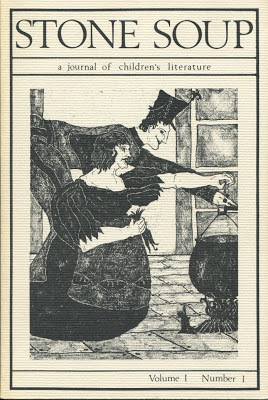 Stone Soup is a high-quality magazine that comes out six times a year and consists exclusively of stories and art created completely by kids. In what I feel is high praise indeed, Ms. magazine called it “The New Yorker of the 8- to 13-set.”
Stone Soup is a high-quality magazine that comes out six times a year and consists exclusively of stories and art created completely by kids. In what I feel is high praise indeed, Ms. magazine called it “The New Yorker of the 8- to 13-set.”
(The sophistication sometimes causes a double-take. The July-August 2012 issue, for example, features a review of the Steve Jobs biography. Yes, the 656-page one aimed at adults.)
I wanted to know the story behind the magazine but found little online. I contacted the founders, both of whom agreed to be interviewed. If you want to know more, please comment and I will do a follow-up.
Gerry Mandel, co-founder and co-editor:
 What was your professional background before Stone Soup?
What was your professional background before Stone Soup?
William Rubel and I started Stone Soup when we were 19-year-old college students, living in the dorms at UC Santa Cruz. We are self-taught. Several [other] classmates were also involved at the beginning.
Where did the idea for Stone Soup come from?
It grew out of a Saturday morning art program, taught by UCSC students for kids in Santa Cruz.
Were you an art or literature major in college?
Yes. We didn’t [anticipate what we’d do with] Stone Soup. We just did it. It pretty much consumed our lives for the last 40 years.
What were the obstacles in founding it?
We got a couple thousand dollars from William's parents. That was all it took.
How did you initially get the word out to bookstores, libraries, and schools?
We created our own mailing list by spending hundreds of hours in the UCSC library, copying names and addresses of schools and libraries out of phone books. Bookstores did not carry magazines in those days.
How did you initially get the word out to potential contributors?
One of our founders was doing some student teaching in local schools. We also got work from Teachers & Writers Collaborative in New York.
Any funny/painful/unusual stories from the early days of the magazine?
Can't think of any right now.
Have submissions been steady throughout the life of the magazine, have they steadily increased from year to year, or has it fluctuated?
They increased each year for many years, now they are pretty stable at about 10,000 a year.
What competing magazines, if any, have come and gone over the years?
There have not been many. Shoe Tree was one. Skipping Stones and Creative Kids are both still around.
You don’t run ads. How do you keep the magazine going?
We support the magazine with subscription sales.
I see your ads in The New Yorker often, so they must have a positive effect. But do you have a way to quantify that effect—in other words, how do you know how many new readers Stone Soup acquires because of those ads? (New Yorker ads are costly!)
We do keep track of responses. We ask subscribers how they heard about us.
Roughly what percentage of your subscribers cite the New Yorker ad as the catalyst?
I don’t know. We spend less than we make and that’s the criterion.
Have any magazine features been retired over the years? (I seem to remember that you once ran photographs?) Have you run nonfiction (including personal essay)? If not, would you consider it?
We don't distinguish between fiction and nonfiction. We are looking for good stories. We used to run stand-alone art pages. All the art we publish now is in the form of illustrations [accompanying stories]. We used to publish work by kids as young as 3. Now most of the work we publish is by 10- to 13-year-olds, with an occasional piece by an 8- or 9-year-old.
What kind of criticisms, if any, has the magazine received over the years?
We don't get much criticism. Some people ask us why we publish more girls than boys. We receive more submissions from girls than boys.
Have you ever received submissions that were concerning in some way and prompted you to follow up with a young person’s parents?
Not that I can remember.
Have you kept in touch with any of your early contributors?
We encourage contributors to keep in touch with us. Every once in a while we hear from someone.
Can you elaborate on a time a former contributor dropped you a line? Was it just to say hi? Was it many years after (i.e. when s/he was an adult)?
No. Hardly anyone does. They’re busier than I am.
[NOTE: I asked this because it could be very motivating for young people to hear that a former contributor went on to do something with writing—or even simply if a former contributor was so affected by being published at a young age that s/he would take the time as an adult to thank them again, etc.]
What is the age of the youngest contributor you’ve published?
Three.
If you have children, did any submit stories when they were of age?
I don’t have children.
Have any Stone Soup stories moved you to tears?
Many stories we publish are emotionally powerful in one way or another. Some are sad, some happy stories can move us to tears. Sometimes it's simply touching to hear about an experience from a child's point of view.
Can you recall an especially funny Stone Soup story?
Sorry, no.
Do you know how often the writers and artists you pair up contact one another to introduce themselves?
Not too often.
How do you know about the times contributors do connect with each other—do they ask you for contact info?
Once or twice, an author has asked to get in touch with the illustrator [that the author was matched up with] to thank her. I don’t know what happens after that.
Have you ever caught an adult misrepresenting his/her age to try to get published in Stone Soup? (I suppose that would be a compliment in its own twisted way!)
No.
Do you know the most submissions you’ve received from one individual?
No. We don't keep track of this.
Do you know the most number of rejections one contributor has received before getting an acceptance?
We don't keep track of this.
Do you know what piece has inspired the most reader reaction/mail?
Sorry, no.
Have any of your contributors gone on to become traditionally published authors as adults?
Not to our knowledge.
Has Stone Soup had any celebrity endorsers—or subscribers (for their children)?
Subscribers, yes. But it is our understanding that they have not subscribed under their own names.
Is your work with Stone Soup full-time or do you have another job as well?
Full time.
Is the magazine part of any programs in schools?
Probably. We don't keep track of this. Our subscribers used to be 80% schools and libraries. Now they are more like 80% families. Many schools have had to cut back on magazine subscriptions.
Do you know of any children’s book authors (besides me) who routinely recommend Stone Soup when speaking in schools?
We hear from them frequently but we don't keep track.
Off the top of your head, can you name any of the authors you have heard from?
No. I do Stone Soup but...I don’t read children’s books. I’m not an expert on children’s literature. I read writing by children but not writing for children. We’re business people and we’re good at what we do. We are probably worldwide experts on what we do. We’re self-taught.
Has the magazine won any awards?
Not really.
Have you given other interviews about Stone Soup?
Many. Stone Soup has been written up—especially in the early days—everywhere from the Washington Post to the San Francisco Chronicle.
What has been your proudest Stone Soup moment?
I am happy that Stone Soup provides a quality forum for young readers, writers, and artists.
Is there anything you’ve wanted to do with the magazine but haven’t yet done?
We're working on a redesign.
William Rubel, CEO, co-founder, and co-editor, responded to multiple questions with one conversational answer:
 I thought of the idea for Stone Soup when I was teaching children writing and art in a Saturday morning program when I was in my second year of college at the University of California at Santa Cruz. It occurred to me that while we, as college students, studied work by adults there was no work by kids for kids to study. No models of excellence by their peers.
I thought of the idea for Stone Soup when I was teaching children writing and art in a Saturday morning program when I was in my second year of college at the University of California at Santa Cruz. It occurred to me that while we, as college students, studied work by adults there was no work by kids for kids to study. No models of excellence by their peers.
It also occurred to me that one couldn't make money—or recoup costs—through selling a book locally. For some reason it occurred to me that as there are so many schools and libraries in the United States that I'd only have to sell to a very small percentage of them to have a viable business. This was true.
We knew nothing about business but had the energy of being young and it was also a different time. I got together a group of friends from this Saturday morning art program for kids and we started Stone Soup. We got our first mailing list by typing names out of phone books at the university library. Initial responses from our directly mail pieces (typed) were in the range of 10%.
Looking back it was a golden time for starting projects. It was a transitional time for typesetting and printing. The very beginnings of the do-it-yourself era.
From the first we have made money off of the magazine's cover price. American children's magazines don't run ads, and besides, ads in small magazines are not economic for advertisers. Obviously, we haven't become rich from the magazine, but it has provided a livelihood doing what we care about.
I have a daughter who is 5½ so it is some time now before she might contribute to Stone Soup.
I have not been there full time for fifteen years, at least. But I am the CEO. After nearly forty years we are still truly excited by much of the material we publish. We believe in children as authors and artists of genuinely creative material.
As publishing moves into another revolutionary time we, like other publishers, have no idea what the future holds for print. On the other hand, it seems to us that we are looking forward to a time of unprecedented creativity and we are working to transform our own business so that we will be able to thrive in the new publishing environments as they unfold—and hopefully grow much bigger so we can reach more children than we do now and thus inspire more children to take writing and art seriously as a means of substantive self-expression.
 Stone Soup is a high-quality magazine that comes out six times a year and consists exclusively of stories and art created completely by kids. In what I feel is high praise indeed, Ms. magazine called it “The New Yorker of the 8- to 13-set.”
Stone Soup is a high-quality magazine that comes out six times a year and consists exclusively of stories and art created completely by kids. In what I feel is high praise indeed, Ms. magazine called it “The New Yorker of the 8- to 13-set.”(The sophistication sometimes causes a double-take. The July-August 2012 issue, for example, features a review of the Steve Jobs biography. Yes, the 656-page one aimed at adults.)
I wanted to know the story behind the magazine but found little online. I contacted the founders, both of whom agreed to be interviewed. If you want to know more, please comment and I will do a follow-up.
Gerry Mandel, co-founder and co-editor:
 What was your professional background before Stone Soup?
What was your professional background before Stone Soup?William Rubel and I started Stone Soup when we were 19-year-old college students, living in the dorms at UC Santa Cruz. We are self-taught. Several [other] classmates were also involved at the beginning.
Where did the idea for Stone Soup come from?
It grew out of a Saturday morning art program, taught by UCSC students for kids in Santa Cruz.
Were you an art or literature major in college?
Yes. We didn’t [anticipate what we’d do with] Stone Soup. We just did it. It pretty much consumed our lives for the last 40 years.
What were the obstacles in founding it?
We got a couple thousand dollars from William's parents. That was all it took.
How did you initially get the word out to bookstores, libraries, and schools?
We created our own mailing list by spending hundreds of hours in the UCSC library, copying names and addresses of schools and libraries out of phone books. Bookstores did not carry magazines in those days.
How did you initially get the word out to potential contributors?
One of our founders was doing some student teaching in local schools. We also got work from Teachers & Writers Collaborative in New York.
Any funny/painful/unusual stories from the early days of the magazine?
Can't think of any right now.
Have submissions been steady throughout the life of the magazine, have they steadily increased from year to year, or has it fluctuated?
They increased each year for many years, now they are pretty stable at about 10,000 a year.
What competing magazines, if any, have come and gone over the years?
There have not been many. Shoe Tree was one. Skipping Stones and Creative Kids are both still around.
You don’t run ads. How do you keep the magazine going?
We support the magazine with subscription sales.
I see your ads in The New Yorker often, so they must have a positive effect. But do you have a way to quantify that effect—in other words, how do you know how many new readers Stone Soup acquires because of those ads? (New Yorker ads are costly!)
We do keep track of responses. We ask subscribers how they heard about us.
Roughly what percentage of your subscribers cite the New Yorker ad as the catalyst?
I don’t know. We spend less than we make and that’s the criterion.
Have any magazine features been retired over the years? (I seem to remember that you once ran photographs?) Have you run nonfiction (including personal essay)? If not, would you consider it?
We don't distinguish between fiction and nonfiction. We are looking for good stories. We used to run stand-alone art pages. All the art we publish now is in the form of illustrations [accompanying stories]. We used to publish work by kids as young as 3. Now most of the work we publish is by 10- to 13-year-olds, with an occasional piece by an 8- or 9-year-old.
What kind of criticisms, if any, has the magazine received over the years?
We don't get much criticism. Some people ask us why we publish more girls than boys. We receive more submissions from girls than boys.
Have you ever received submissions that were concerning in some way and prompted you to follow up with a young person’s parents?
Not that I can remember.
Have you kept in touch with any of your early contributors?
We encourage contributors to keep in touch with us. Every once in a while we hear from someone.
Can you elaborate on a time a former contributor dropped you a line? Was it just to say hi? Was it many years after (i.e. when s/he was an adult)?
No. Hardly anyone does. They’re busier than I am.
[NOTE: I asked this because it could be very motivating for young people to hear that a former contributor went on to do something with writing—or even simply if a former contributor was so affected by being published at a young age that s/he would take the time as an adult to thank them again, etc.]
What is the age of the youngest contributor you’ve published?
Three.
If you have children, did any submit stories when they were of age?
I don’t have children.
Have any Stone Soup stories moved you to tears?
Many stories we publish are emotionally powerful in one way or another. Some are sad, some happy stories can move us to tears. Sometimes it's simply touching to hear about an experience from a child's point of view.
Can you recall an especially funny Stone Soup story?
Sorry, no.
Do you know how often the writers and artists you pair up contact one another to introduce themselves?
Not too often.
How do you know about the times contributors do connect with each other—do they ask you for contact info?
Once or twice, an author has asked to get in touch with the illustrator [that the author was matched up with] to thank her. I don’t know what happens after that.
Have you ever caught an adult misrepresenting his/her age to try to get published in Stone Soup? (I suppose that would be a compliment in its own twisted way!)
No.
Do you know the most submissions you’ve received from one individual?
No. We don't keep track of this.
Do you know the most number of rejections one contributor has received before getting an acceptance?
We don't keep track of this.
Do you know what piece has inspired the most reader reaction/mail?
Sorry, no.
Have any of your contributors gone on to become traditionally published authors as adults?
Not to our knowledge.
Has Stone Soup had any celebrity endorsers—or subscribers (for their children)?
Subscribers, yes. But it is our understanding that they have not subscribed under their own names.
Is your work with Stone Soup full-time or do you have another job as well?
Full time.
Is the magazine part of any programs in schools?
Probably. We don't keep track of this. Our subscribers used to be 80% schools and libraries. Now they are more like 80% families. Many schools have had to cut back on magazine subscriptions.
Do you know of any children’s book authors (besides me) who routinely recommend Stone Soup when speaking in schools?
We hear from them frequently but we don't keep track.
Off the top of your head, can you name any of the authors you have heard from?
No. I do Stone Soup but...I don’t read children’s books. I’m not an expert on children’s literature. I read writing by children but not writing for children. We’re business people and we’re good at what we do. We are probably worldwide experts on what we do. We’re self-taught.
Has the magazine won any awards?
Not really.
Have you given other interviews about Stone Soup?
Many. Stone Soup has been written up—especially in the early days—everywhere from the Washington Post to the San Francisco Chronicle.
What has been your proudest Stone Soup moment?
I am happy that Stone Soup provides a quality forum for young readers, writers, and artists.
Is there anything you’ve wanted to do with the magazine but haven’t yet done?
We're working on a redesign.
William Rubel, CEO, co-founder, and co-editor, responded to multiple questions with one conversational answer:
 I thought of the idea for Stone Soup when I was teaching children writing and art in a Saturday morning program when I was in my second year of college at the University of California at Santa Cruz. It occurred to me that while we, as college students, studied work by adults there was no work by kids for kids to study. No models of excellence by their peers.
I thought of the idea for Stone Soup when I was teaching children writing and art in a Saturday morning program when I was in my second year of college at the University of California at Santa Cruz. It occurred to me that while we, as college students, studied work by adults there was no work by kids for kids to study. No models of excellence by their peers.It also occurred to me that one couldn't make money—or recoup costs—through selling a book locally. For some reason it occurred to me that as there are so many schools and libraries in the United States that I'd only have to sell to a very small percentage of them to have a viable business. This was true.
We knew nothing about business but had the energy of being young and it was also a different time. I got together a group of friends from this Saturday morning art program for kids and we started Stone Soup. We got our first mailing list by typing names out of phone books at the university library. Initial responses from our directly mail pieces (typed) were in the range of 10%.
Looking back it was a golden time for starting projects. It was a transitional time for typesetting and printing. The very beginnings of the do-it-yourself era.
From the first we have made money off of the magazine's cover price. American children's magazines don't run ads, and besides, ads in small magazines are not economic for advertisers. Obviously, we haven't become rich from the magazine, but it has provided a livelihood doing what we care about.
I have a daughter who is 5½ so it is some time now before she might contribute to Stone Soup.
I have not been there full time for fifteen years, at least. But I am the CEO. After nearly forty years we are still truly excited by much of the material we publish. We believe in children as authors and artists of genuinely creative material.
As publishing moves into another revolutionary time we, like other publishers, have no idea what the future holds for print. On the other hand, it seems to us that we are looking forward to a time of unprecedented creativity and we are working to transform our own business so that we will be able to thrive in the new publishing environments as they unfold—and hopefully grow much bigger so we can reach more children than we do now and thus inspire more children to take writing and art seriously as a means of substantive self-expression.
Published on September 16, 2012 04:28
September 15, 2012
“Bill the Boy Wonder” comments on Amazon
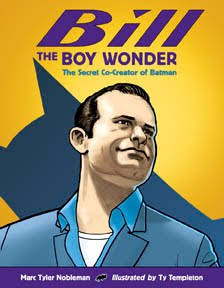 “For kids, it's a big colorful picture book with a story both interesting and a little sad. For adult fans, it's a rare chance to get to know more about someone whose work you've admired for years...whether or not you ever heard his name. Who created Batman? Not the easiest question to answer but Marc Tyler Nobleman points his own finger...at Bill.”
“For kids, it's a big colorful picture book with a story both interesting and a little sad. For adult fans, it's a rare chance to get to know more about someone whose work you've admired for years...whether or not you ever heard his name. Who created Batman? Not the easiest question to answer but Marc Tyler Nobleman points his own finger...at Bill.”“This book is a must have for every Batman fan and comic reader in general. … Done very effectively and well.”
“Thank you Bill Finger for the creativity and brilliant writing of the Batman story. And thank you Marc Tyler Nobleman for creating your interesting and clever book about the co-writer [she meant creator] of Batman, Bill Finger!”
Please check back in case I add to this.
Published on September 15, 2012 04:13
September 13, 2012
Read and return in the airport
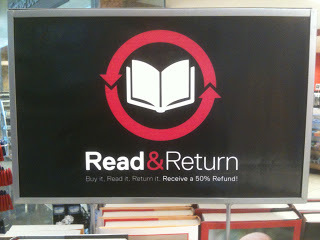
In some airports, bookstores dress up as libraries. All that matters is that people are reading, baby.
Published on September 13, 2012 04:00
September 12, 2012
“Bill the Boy Wonder” alternate titles
Before Bill the Boy Wonder: The Secret Co-Creator of Batman, no telling of the Batman creation story had put Bill (rightfully) at the center.
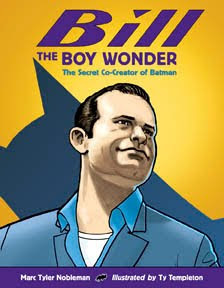 I was left wide open for choice of titles and made a long list starting in 2006.
I was left wide open for choice of titles and made a long list starting in 2006.
Ones I left in Crime Alley:
Finger Writing—I still like this one, and The Nervous Breakdown recently titled its interview with me “Finger Painting.”
Finger the Boy Wonder—I wish I could have used this instead of Bill the Boy Wonder because the number of syllables is the same as the source phrase, “Robin the Boy Wonder,” plus the word “Finger” is more fun. However, as you surely immediately noticed, this phrase could come across as (wildly) inappropriate so had to be discarded with extreme prejudice.
The Father of Batman—Carmine Infantino suggested this, and it became the title of one of the two sections of the Author’s Note.
Crusader Without a Cape—Charles Sinclair suggested this.
Finger at Bat—I ended up using this phrase in the book.
Finger Prints—I used this in the book, too.
Finger Goes Batty—Too flip.
Bill’s Gimmick Book or The Gimmick Boy—These refer to Bill’s legendary notebooks of story ideas, but they were not specific enough to be the title.
Living in a Hiding Place—This comes from one of my favorite songs, “Live in a Hiding Place” by Idlewild. That sorrowful phrase and much of the lyrics could be talking about Bill, but the phrase does not call to mind Batman.
The Ghost of Batman—People who worked on comics anonymously were called “ghosts.” But I did not want the title to sound negative.
Bill the Boy Writer—Eh.
Bill the Man Wonder—Dear lord no.
Bat and Bill—A play on “bat and ball.” And an unnecessary one.
Bill Finger: Batman's Other Secret Identity—Too literal and I knew this angle would come up in multiple other ways.
The Secret Identities of Bill Finger: Co-Creator of Batman—I quite like this one. “Secret identity” singular would not stand out with respect to a superhero book because the idea is so prevalent in superhero mythos. However, “secret identities” plural is unusual and therefore grabby. That’s why “multiple secret identities” is the theme of the book.
Titles I considered for the author’s note:
“His Identity Remains Unknown”—It appears in the first paragraph of the Author’s Note.
“Now I’m Light Again”—This comes from the only known note in Bill’s handwriting, reproduced on the last page of Bill the Boy Wonder. It’s especially haunting as the last line. If only Bill could’ve held onto that lightness...
Titles written to me in error, or in jest:
Bill the Wonder Boy—error. (More to come, most likely.)
Bat Boys—jest. And cute. But, of course, as noted at top, I’m focusing on just one Bat Boy.
 I was left wide open for choice of titles and made a long list starting in 2006.
I was left wide open for choice of titles and made a long list starting in 2006. Ones I left in Crime Alley:
Finger Writing—I still like this one, and The Nervous Breakdown recently titled its interview with me “Finger Painting.”
Finger the Boy Wonder—I wish I could have used this instead of Bill the Boy Wonder because the number of syllables is the same as the source phrase, “Robin the Boy Wonder,” plus the word “Finger” is more fun. However, as you surely immediately noticed, this phrase could come across as (wildly) inappropriate so had to be discarded with extreme prejudice.
The Father of Batman—Carmine Infantino suggested this, and it became the title of one of the two sections of the Author’s Note.
Crusader Without a Cape—Charles Sinclair suggested this.
Finger at Bat—I ended up using this phrase in the book.
Finger Prints—I used this in the book, too.
Finger Goes Batty—Too flip.
Bill’s Gimmick Book or The Gimmick Boy—These refer to Bill’s legendary notebooks of story ideas, but they were not specific enough to be the title.
Living in a Hiding Place—This comes from one of my favorite songs, “Live in a Hiding Place” by Idlewild. That sorrowful phrase and much of the lyrics could be talking about Bill, but the phrase does not call to mind Batman.
The Ghost of Batman—People who worked on comics anonymously were called “ghosts.” But I did not want the title to sound negative.
Bill the Boy Writer—Eh.
Bill the Man Wonder—Dear lord no.
Bat and Bill—A play on “bat and ball.” And an unnecessary one.
Bill Finger: Batman's Other Secret Identity—Too literal and I knew this angle would come up in multiple other ways.
The Secret Identities of Bill Finger: Co-Creator of Batman—I quite like this one. “Secret identity” singular would not stand out with respect to a superhero book because the idea is so prevalent in superhero mythos. However, “secret identities” plural is unusual and therefore grabby. That’s why “multiple secret identities” is the theme of the book.
Titles I considered for the author’s note:
“His Identity Remains Unknown”—It appears in the first paragraph of the Author’s Note.
“Now I’m Light Again”—This comes from the only known note in Bill’s handwriting, reproduced on the last page of Bill the Boy Wonder. It’s especially haunting as the last line. If only Bill could’ve held onto that lightness...
Titles written to me in error, or in jest:
Bill the Wonder Boy—error. (More to come, most likely.)
Bat Boys—jest. And cute. But, of course, as noted at top, I’m focusing on just one Bat Boy.
Published on September 12, 2012 04:00
September 9, 2012
The closest I came to Jerry Siegel
In June, I posted a rundown of comic books that made an impact on me in my childhood. One was a 1985 issue in which a letter I wrote was printed. It was, in fact, the only comic book that ran a letter from me (though I don't remember if I ever wrote any others).
Superhero writer Jamie Coville wrote in with an observation that startled me. An observation that caused Jamie to speculate it could have been the inspiration for Boys of Steel: The Creators of Superman.
You will figure it out:
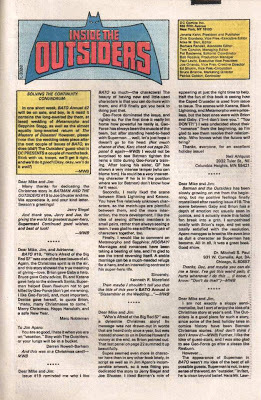 I almost got the chills when I saw that.
I almost got the chills when I saw that.

Superhero writer Jamie Coville wrote in with an observation that startled me. An observation that caused Jamie to speculate it could have been the inspiration for Boys of Steel: The Creators of Superman.
You will figure it out:
 I almost got the chills when I saw that.
I almost got the chills when I saw that.
Published on September 09, 2012 04:49
September 7, 2012
"Bill the Boy Wonder" makes 2012 ABC Best Books for Children Catalog
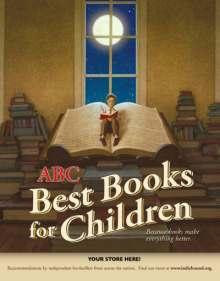 Shipping in October.
Shipping in October.I'm honored to be among books by friends including Aaron Reynolds and Peter Brown (Creepy Carrots!), Doreen Rappaport (Helen's Big World), Katherine Marsh (Jepp, Who Defied the Stars), Scott Magoon (Chopsticks), Tad Hills (Rocket Writes a Story), Raina Telgemeier (Drama), Dan Santat (multiple titles vroom!), Marla Frazee (multiple woo-hoo!), and the late Ellen Levine (Henry's Freedom Box).
Published on September 07, 2012 04:53
September 6, 2012
People you may know: Jerry Siegel and Joe Shuster and Bill Finger
Though Jerry Siegel and Joe Shuster and Bill Finger began making heroic history at the same time, I know of only a couple of concrete overlaps between the Boys of Steel and Bill the Boy Wonder.
At the sunrise of Superman, Jerry and Joe lived in Cleveland, but did go to New York to meet with people at what became DC Comics. I don’t know how often but do know that
Jerry and Joe were friends with Jerry Robinson who was a good friend of Finger’s; both Robinson and Finger lived in New York. In the 1940s, Jerry and a couple of other cartoonists he lived with had parties and all of them would’ve been there at one time or another. I was sure to acknowledge this in Bill the Boy Wonder: The Secret Co-Creator of Batman.
Also, there’s this:
Tragic and almost mean-spirited as it is, the way the writer phrased this did make me chuckle.
While we’re pulling back the curtain, here is another way in which the three men overlapped.
Somewhat related, onetime Batman ghost artist Lew Sayre Schwartz told me a great (and potentially history-changing) story about how Jerry and Joe tried to get Bob Kane to go in with them on a lawsuit against DC in the 1940s. Lew was at Bob’s when Jerry and Joe showed up and overheard some of the attempt. Bob infamously declined, and went on to get rich on Batman his own way. I hope someone recorded the full story before Lew passed away in 2011.
At the sunrise of Superman, Jerry and Joe lived in Cleveland, but did go to New York to meet with people at what became DC Comics. I don’t know how often but do know that
Jerry and Joe were friends with Jerry Robinson who was a good friend of Finger’s; both Robinson and Finger lived in New York. In the 1940s, Jerry and a couple of other cartoonists he lived with had parties and all of them would’ve been there at one time or another. I was sure to acknowledge this in Bill the Boy Wonder: The Secret Co-Creator of Batman.
Also, there’s this:
Joanne Siegel…mentions that Bill Finger used to try and borrow money from her husband in washrooms, bringing the magic of a life in the comics industry into keen focus for the younger generation in attendance.
Tragic and almost mean-spirited as it is, the way the writer phrased this did make me chuckle.
While we’re pulling back the curtain, here is another way in which the three men overlapped.
Somewhat related, onetime Batman ghost artist Lew Sayre Schwartz told me a great (and potentially history-changing) story about how Jerry and Joe tried to get Bob Kane to go in with them on a lawsuit against DC in the 1940s. Lew was at Bob’s when Jerry and Joe showed up and overheard some of the attempt. Bob infamously declined, and went on to get rich on Batman his own way. I hope someone recorded the full story before Lew passed away in 2011.
Published on September 06, 2012 04:22
September 5, 2012
Whatzit and the Terrible Harry
One of my favorite books from childhood is Harry and the Terrible Whatzit (1977) by Dick Gackenbach (1927-2001).
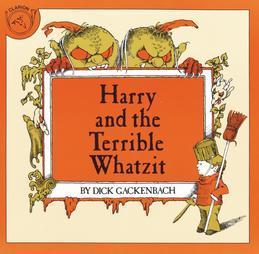 I recently revisited it for the first time in decades. It does exist to teach a lesson, and that lesson is not as subtle as I think it could have been. Despite this, I still find it charming both narratively and visually. It stayed with me—and stayed in print—for a reason.
I recently revisited it for the first time in decades. It does exist to teach a lesson, and that lesson is not as subtle as I think it could have been. Despite this, I still find it charming both narratively and visually. It stayed with me—and stayed in print—for a reason.
However, something struck me as an adult that almost certainly didn’t as a child: the Whatzit is not at all terrible. (At least his behavior; I can’t speak for his odor.)
In fact, it is Harry who shoots first and only at that point does the Whatzit get mad. But even then he’s not all that scary. (Again, talking behavior only. Some kids are frightened by his appearance.)
Here is how Harry reacts when he thinks the Whatzit is lying when it says it does not know where Harry’s mom is.
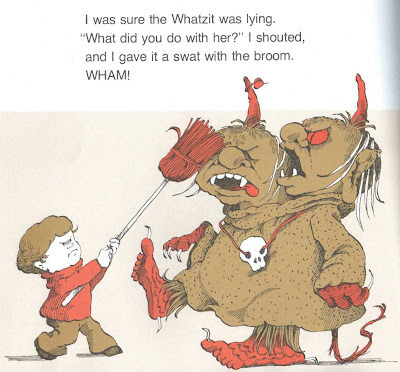 That might be sending an unintended message to some kids: if you don’t believe someone, hit him. Or more broadly, if you don’t like what someone is doing, hit him. Now that’s scary.
That might be sending an unintended message to some kids: if you don’t believe someone, hit him. Or more broadly, if you don’t like what someone is doing, hit him. Now that’s scary.
Harry goes on to whack the Whatzit two more times, pull its tail, threaten it, and finally twist one of its two noses. Whatzit and Terrible Harry is more like it.
Yet Harry is meant to be the hero of the book. Yes, he stands up to a creepy-looking basement dweller to protect/save/avenge his mom, but clearly he is not a believer in “innocent until proven guilty.” And he never seems that afraid in the first place.
So the book pits a brave boy against a harmless monster to inspire kids to conquer their own fears. What Harry was really afraid of all along—like most of us—is the unknown. But you can’t whack that with a broom.

 I recently revisited it for the first time in decades. It does exist to teach a lesson, and that lesson is not as subtle as I think it could have been. Despite this, I still find it charming both narratively and visually. It stayed with me—and stayed in print—for a reason.
I recently revisited it for the first time in decades. It does exist to teach a lesson, and that lesson is not as subtle as I think it could have been. Despite this, I still find it charming both narratively and visually. It stayed with me—and stayed in print—for a reason.However, something struck me as an adult that almost certainly didn’t as a child: the Whatzit is not at all terrible. (At least his behavior; I can’t speak for his odor.)
In fact, it is Harry who shoots first and only at that point does the Whatzit get mad. But even then he’s not all that scary. (Again, talking behavior only. Some kids are frightened by his appearance.)
Here is how Harry reacts when he thinks the Whatzit is lying when it says it does not know where Harry’s mom is.
 That might be sending an unintended message to some kids: if you don’t believe someone, hit him. Or more broadly, if you don’t like what someone is doing, hit him. Now that’s scary.
That might be sending an unintended message to some kids: if you don’t believe someone, hit him. Or more broadly, if you don’t like what someone is doing, hit him. Now that’s scary. Harry goes on to whack the Whatzit two more times, pull its tail, threaten it, and finally twist one of its two noses. Whatzit and Terrible Harry is more like it.
Yet Harry is meant to be the hero of the book. Yes, he stands up to a creepy-looking basement dweller to protect/save/avenge his mom, but clearly he is not a believer in “innocent until proven guilty.” And he never seems that afraid in the first place.
So the book pits a brave boy against a harmless monster to inspire kids to conquer their own fears. What Harry was really afraid of all along—like most of us—is the unknown. But you can’t whack that with a broom.
Published on September 05, 2012 04:33

